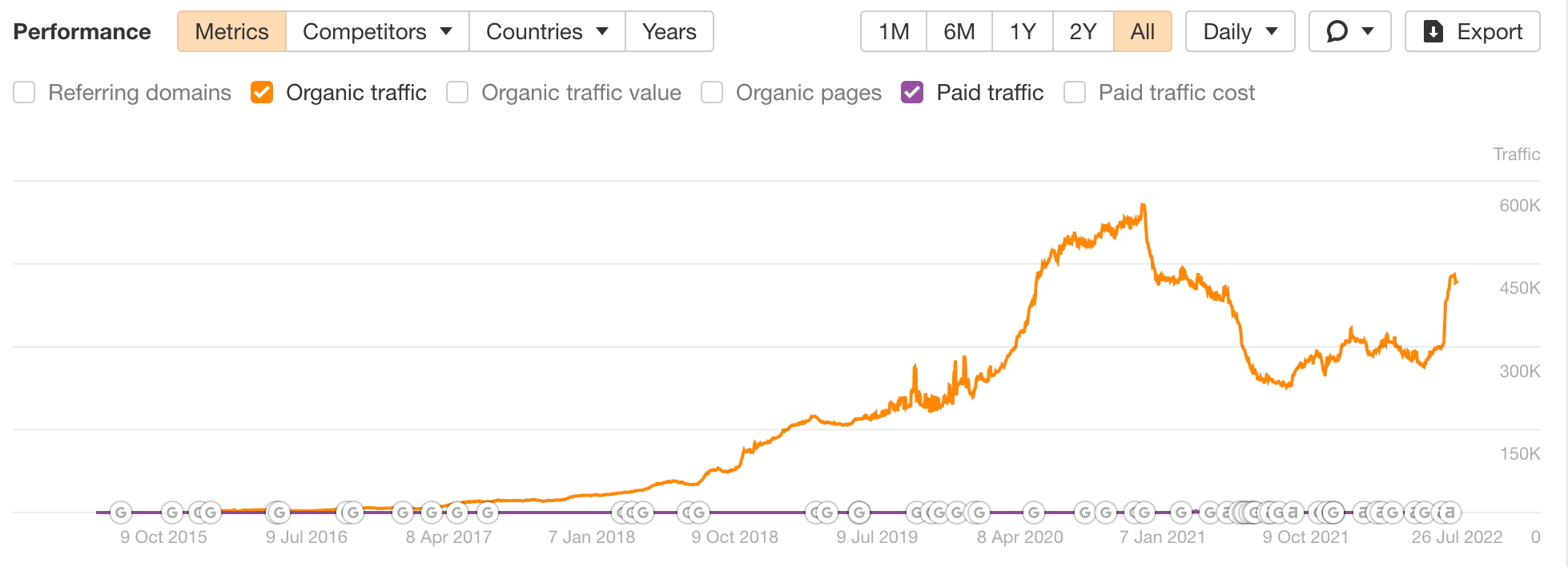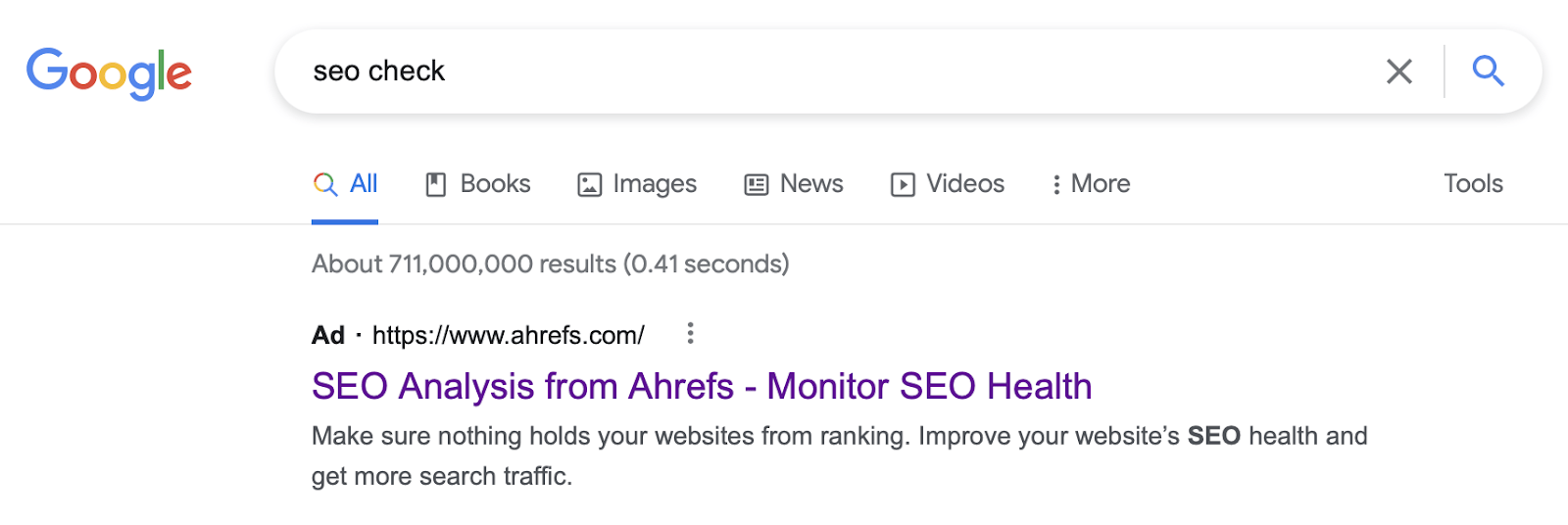The primary distinction between search engine optimization (SEO) and pay-per-click (PPC) marketing lies in their traffic sources. SEO aims for organic search traffic, while PPC targets paid search, social, and display traffic. This post will guide you in determining which approach suits your business better.
What is SEO?
SEO involves optimizing your web pages to rank higher in organic search engine results. It encompasses four key areas:
- Keyword Research: Identifying the words and phrases your target audience uses when searching.
- On-page SEO: Creating content aligned with searchers’ intent.
- Off-page SEO: Building trust and authority through external links.
- Technical SEO: Ensuring search engines can discover, crawl, and index your content.
- Keyword Research Keyword research entails understanding the keywords your potential customers use in search engines. This process often involves using tools like Ahrefs’ Keywords Explorer. For instance, to find keywords for an online coffee store:
- Brainstorm potential search terms.
- Input them into Ahrefs’ Keywords Explorer.
- Analyze the Matching terms report.
- On-page SEO On-page SEO focuses on creating content that aligns with searchers’ intent. Understanding why people make certain queries, known as search intent, is crucial. For example, users searching for “how to make kefir” seek learning resources, while those looking for “basketball shoes” intend to make a purchase.
On-page SEO involves various elements, including strategically placing keywords in titles, crafting compelling titles, using concise URLs, and optimizing images.
- Off-page SEO Off-page SEO involves activities outside your website to demonstrate to Google that your pages deserve to rank higher. One crucial aspect is building high-quality backlinks, as they are among Google’s top three ranking factors. Backlinks serve as endorsements from other websites.
You can identify who is linking to your site using tools like Ahrefs’ Site Explorer, accessible for free through Ahrefs Webmaster Tools. Reviewing the Backlinks report provides insights into your site’s linking profile. Additionally, for local SEO, factors like reviews and citations play significant roles.
- Technical SEO Technical SEO focuses on ensuring search engines can easily discover, crawl, and index your website’s content. This is essential because without visibility, you cannot rank in organic search results.
Technical SEO addresses various aspects, such as optimizing site structure, improving page load speed, and enhancing mobile responsiveness. For instance, if search engines are prevented from crawling your content, your chances of ranking diminish significantly.
SEO: Pros and Cons
Contemplating an investment in SEO? Let’s weigh the advantages and disadvantages of this marketing strategy.
Pros:
- Staying Power of Organic Traffic: Achieving a high Google ranking for your target keywords can result in consistent organic traffic to your site. Even if you pause publishing, the traffic flow can persist.
Example: The Ahrefs blog enjoys steady organic traffic, as depicted in the traffic chart via Ahrefs’ Site Explorer.
- Long-Term Cost Efficiency: SEO can be more cost-effective in the long run compared to purchasing traffic through PPC. For instance, the Ahrefs blog generates substantial organic visits, which would incur substantial costs if acquired through PPC.
Example: Estimated costs for buying similar traffic through PPC are considerably higher compared to the resources invested in SEO.

Cons:
- Time Intensive: SEO is a patient game. It takes time for pages to rank on Google. Research indicates that only a fraction of pages in the top 10 results were published within a year.
Example: The pie chart illustrates the age distribution of pages ranking in Google’s top 10.
- Need for Unique and Authoritative Content: To excel in SEO, you require expertise and authoritative content. Users prefer learning from experts, especially for topics like finance and health. Google emphasizes expertise, authority, and trustworthiness (E-A-T) for such topics.
Example: Google prioritizes content that demonstrates expertise, particularly for Your Money or Your Life (YMYL) topics.
- Competitive Keywords: Targeting competitive keywords can be challenging, especially for new entrants. Established brands dominate these spaces, making it daunting for newcomers.
Example: The SERP overview for “basketball shoes” highlights the dominance of well-known brands like Nike, Dick’s Sporting Goods, and Foot Locker.
While SEO offers long-term benefits, it requires patience, expertise, and strategic resource allocation to navigate its challenges effectively.
What is PPC?
PPC (Pay-Per-Click) marketing is a form of online advertising where advertisers pay a fee each time someone clicks on their ad. While search ads are the most common format, social media ads also fall under this category.

How PPC Advertising Works:
- Keyword Research: Just like in SEO, keyword research is crucial in PPC advertising. It involves identifying the keywords your customers are searching for.
- Bid Setting: Bid setting determines how much you’re willing to pay Google for each ad click. Your ad’s visibility can be affected if competitors outbid you.
- Ad Creation: Ad creation involves crafting compelling and relevant ads. You decide what your ad will say and where it will direct users, such as sending them to a specific webpage.
- Audience Targeting: Audience targeting allows you to choose who sees your ad based on demographics, interests, location, and more.
SIDENOTE: The principles behind PPC advertising for social ads are similar to those for search ads.
Additional Aspects of PPC Advertising:
- Quality Score: Google assigns a Quality Score to your ads, indicating their relevance and usefulness. Higher Quality Scores lead to increased ad visibility and lower click costs.
- Audience Targeting Details: Audience targeting allows for precise customization of who sees your ads based on various criteria.
PPC: Pros and Cons
Considering investing in PPC? Let’s examine the advantages and disadvantages.
Pros:
- Speedy Results: PPC delivers almost instant results. You can initiate a campaign on any ad platform promptly.
- Precise Targeting: PPC platforms offer granular targeting options, enabling you to reach specific demographics, geographic regions, and interests.
- Quick Experimentation: PPC facilitates rapid experimentation. You can set up campaigns, conduct A/B tests, and promptly analyze results to refine strategies.
Comparison: Unlike SEO, where results take time to manifest, PPC provides swift feedback on the effectiveness of changes or tactics.
Cons:
- Costly Competition: PPC can become prohibitively expensive, especially in competitive industries like insurance. Bidding on keywords such as “car insurance” may incur high costs, with average CPC values reaching $40 per click.
- Diminishing Returns Over Time: The effectiveness of PPC campaigns can decline with prolonged exposure. Ad fatigue sets in as audiences become accustomed to seeing the same ads repeatedly. Constantly refreshing ad content is necessary to combat ad blindness and maintain effectiveness.
- Financial Investment Required: Launching a PPC campaign necessitates an initial budget investment. It may take time to optimize campaigns effectively, and you may incur losses during the initial phases of campaign management.

While PPC offers rapid results and precise targeting capabilities, it comes with potential downsides such as escalating costs, diminishing returns over time, and the need for financial resources to initiate campaigns. Careful planning and continuous optimization are essential for maximizing the benefits of PPC advertising.
SEO vs. PPC: Choosing the Right Strategy
Deciding between SEO and PPC depends on various factors. Let’s explore scenarios where each channel may be more advantageous:
- Innovative Product Launch: If you’re introducing a groundbreaking product with limited existing demand, leveraging social media PPC can effectively build awareness. For instance, Uber initially faced minimal search interest in “ride hailing,” making SEO less relevant for their early-stage marketing efforts.
Note: SEO is preferable when there’s existing demand for your product or niche.
- Product Launch or Limited-Time Offer: For time-sensitive promotions like product launches or one-time events, PPC offers immediate visibility. SEO’s time-intensive nature may result in missed opportunities, making PPC or influencer marketing more suitable.
- Informational Keywords or Top-of-Funnel Content: Keywords focusing on learning rather than buying are less suitable for PPC due to low immediate conversion rates. Creating SEO-driven content, such as blog posts or guides, aligns better with user intent and provides long-term value.
- Promotion of Commercial Content: Commercial content like landing or product pages may struggle to attract organic links. In such cases, PPC allows direct traffic to these pages, bypassing the need for link-building strategies.
- Limited Budget Constraints: SEO and content marketing are viable options when budget constraints limit PPC advertising. These organic strategies offer sustainable traffic growth without substantial financial investment.
- Website Flipping Strategy: For website flippers aiming to enhance site value, SEO offers long-term stability and increased valuation. Organic traffic signals strong site performance to potential buyers, making it an attractive investment. In contrast, reliance on PPC entails ongoing management and carries higher business risk.
By considering these scenarios and aligning them with your marketing goals, you can determine whether SEO or PPC—or a combination of both—best suits your needs.
SEO and PPC: Achieving Synergy
The most successful businesses leverage both SEO and PPC to maximize their online presence. Here’s how you can integrate these strategies for optimal results:
- Promote Content with PPC Ads: Use PPC ads to amplify the reach of your content. Investing time and resources into content creation is futile if it goes unnoticed. By running ads on platforms like Facebook, Twitter, and Quora, you can ensure your content reaches a wider audience of interested individuals.
Example: Utilizing Facebook ads, Twitter promotions, and Quora ads alongside content distribution.
- Implement Retargeting Campaigns: Retargeting enables you to reconnect with visitors who have previously interacted with your website but left without completing desired actions. By displaying targeted ads to these visitors as they browse the web, you can encourage them to return and engage further, potentially leading to conversions.
Example: Using cookies to retarget visitors who abandon a coffee website, prompting them to revisit and explore offerings.
- Explore Competitors’ Keywords: Analyze your competitors’ PPC strategies to uncover lucrative keywords and opportunities for both PPC and SEO initiatives. Tools like Ahrefs’ Site Explorer provide insights into competitors’ paid keywords, landing pages, and ad copy, allowing you to identify valuable keywords to target.
Example: Using Ahrefs’ Paid keywords report to discover competitor keywords and tailor PPC and SEO campaigns accordingly.
Final Thoughts: Just like classic pairings such as fish and chips or wine and cheese, SEO and PPC complement each other seamlessly. By integrating both strategies into your digital marketing efforts, you can harness the strengths of each channel to drive traffic, increase visibility, and achieve optimal results for your business.
For further inquiries or assistance, feel free to contact Web Solution Centre.
 Request A Quote
Request A Quote Have a project in mind? Get in Touch
Have a project in mind? Get in Touch